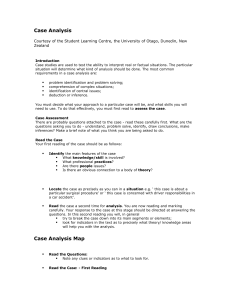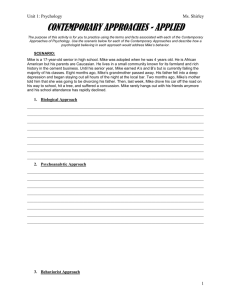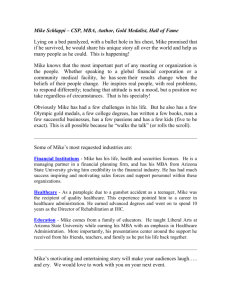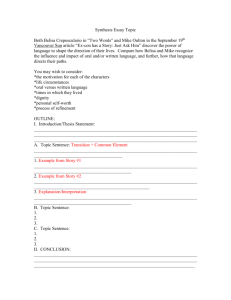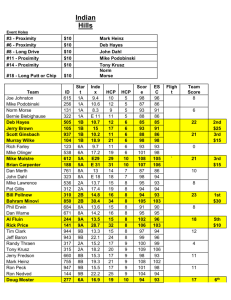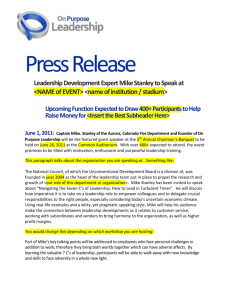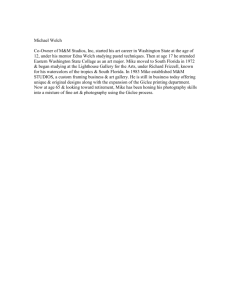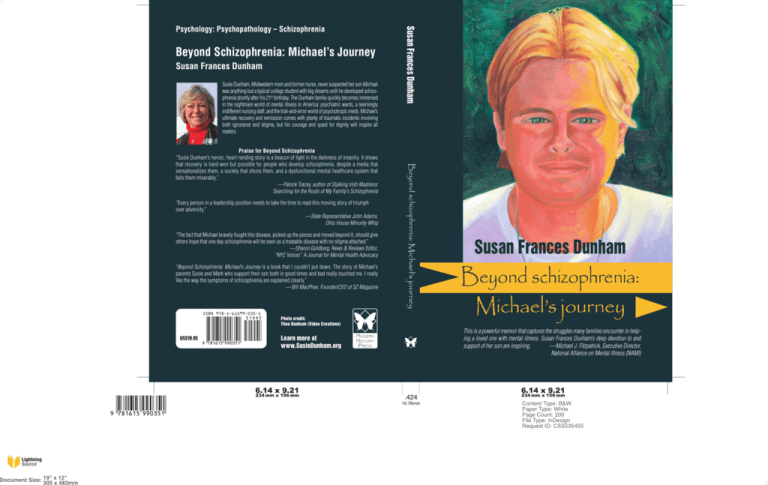
Beyond Schizophrenia: Michael’s Journey
Susan Frances Dunham
Susie Dunham, Midwestern mom and former nurse, never suspected her son Michael
was anything but a typical college student with big dreams until he developed schizophrenia shortly after his 21st birthday. The Dunham family quickly becomes immersed
in the nightmare world of mental illness in America: psychiatric wards, a seemingly
indifferent nursing staff, and the trial-and-error world of psychotropic meds. Michael’s
ultimate recovery and remission comes with plenty of traumatic incidents involving
both ignorance and stigma, but his courage and quest for dignity will inspire all
readers.
“Every person in a leadership position needs to take the time to read this moving story of triumph
over adversity.”
—State Representative John Adams,
Ohio House Minority Whip
“The fact that Michael bravely fought this disease, picked up the pieces and moved beyond it, should give
others hope that one day schizophrenia will be seen as a treatable disease with no stigma attached.”
—Sharon Goldberg, News & Reviews Editor,
“NYC Voices”: A Journal for Mental Health Advocacy
“Beyond Schizophrenia: Michael’s Journey is a book that I couldn’t put down. The story of Michael’s
parents Susie and Mark who support their son both in good times and bad really touched me. I really
like the way the symptoms of schizophrenia are explained clearly.”
—Bill MacPhee, Founder/CEO of SZ Magazine
Photo credit:
Theo Dunham (Video Creations)
US$19.95
Learn more at
www.SusieDunham.org
Beyond schizophrenia: Michael’s journey
Praise for Beyond Schizophrenia
“Susie Dunham’s heroic, heart-rending story is a beacon of light in the darkness of insanity. It shows
that recovery is hard-won but possible for people who develop schizophrenia, despite a media that
sensationalizes them, a society that shuns them, and a dysfunctional mental healthcare system that
fails them miserably.”
—Patrick Tracey, author of Stalking Irish Madness:
Searching for the Roots of My Family’s Schizophrenia
Susan Frances Dunham
Psychology: Psychopathology – Schizophrenia
Susan Frances Dunham
Beyond schizophrenia:
Michael’s journey
This is a powerful memoir that captures the struggles many families encounter in helping a loved one with mental illness. Susan Frances Dunham’s deep devotion to and
support of her son are inspiring.
—Michael J. Fitzpatrick, Executive Director,
National Alliance on Mental Illness (NAMI)
Praise for Beyond Schizophrenia “Susie Dunham’s heroic, heart-rending story in Beyond
Schizophrenia is a beacon of light in the darkness of insanity. It
shows that recovery is hard-won but possible for people who
develop schizophrenia, despite a media that sensationalizes them,
a society that shuns them, and a dysfunctional mental healthcare
system that fails them miserably. All American Mike is more
than “a perfect son.” He’s a shining example of success for 3
million Americans who suffer in silence.”
—Patrick Tracey, author of Stalking Irish Madness:
Searching for the Roots of My Family’s Schizophrenia
“Every person in a leadership position needs to take the time
to read this moving story of triumph over adversity.”
—State Representative John Adams,
Ohio House Minority Whip
“The fact that Michael bravely fought this disease, picked up
the pieces and moved beyond it, should give others hope that one
day schizophrenia will be seen as a treatable disease with no
stigma attached.”
—Sharon Goldberg, News & Reviews Editor,
“NYC Voices”: A Journal for Mental Health Advocacy
“Beyond Schizophrenia: Michael’s Journey is a book that I
couldn’t put down. The story of Michael’s parents Susie and
Mark who support their son both in good times and bad really
touched me. I really like the way the symptoms of schizophrenia
are explained clearly. Beyond Schizophrenia: Michael’s Journey
is a must read.”
—Bill MacPhee, Founder/CEO of SZ Magazine
“Susie Dunham holds nothing back. She is so refreshingly
honest and personal that I found myself wanting to give her and
every family member a big hug through their tears of courage.”
—Larry Hayes, author of Mental Illness and
Your Town: 37 Ways to Help and Heal
“This is a powerful memoir that captures the struggles many
families encounter in helping a loved one with mental illness.
Susan Frances Dunham’s deep devotion to and support of her
son are inspiring.”
—Michael J. Fitzpatrick, Executive Director,
National Alliance on Mental Illness (NAMI)
Reflections of America Series
Modern History Press
Beyond Schizophrenia: Michael’s Journey
Copyright © 2011 Susan Frances Dunham. All Rights Reserved.
from the Reflections of America Series
Cover art by Gary Wittenmyer
Author photo by Theo Dunham (Video Creations)
Cover design by Michal Šplho (www.michalsplho.sk)
Library of Congress Cataloging-in-Publication Data
Dunham, Susan Frances, 1954Beyond schizophrenia : Michael's journey / Susan Frances
Dunham, Michael Dunham.
p. cm. -- (Reflections of America series)
Includes bibliographical references and index.
ISBN-13: 978-1-61599-058-0 (hardcover : alk. paper)
ISBN-10: 1-61599-058-5 (hardcover : alk. paper)
ISBN-13: 978-1-61599-035-1 (pbk. : alk. paper)
ISBN-10: 1-61599-035-6 (pbk. : alk. paper)
1. Dunham, Michael--Mental health. 2. Dunham, Susan Frances,
1954- 3. Schizophrenics--Ohio--Biography. 4. Parents of mentally
ill children--Ohio--Biography. I. Title.
RC514.D863 2011
616.89'80092--dc22
[B]
2010032755
Distributed by Ingram, New Leaf Distributing, Bertram’s Books
(UK), Hachette Livre (FR), Angus & Robertson (AU).
Modern History Press, is an imprint of
Loving Healing Press
5145 Pontiac Trail
Ann Arbor, MI 48105
www.ModernHistoryPress.com
Tollfree 888-761-6268
Fax: 734-663-6861
Contents Foreword .............................................................................. iii Acknowledgments .................................................................. v Prologue ................................................................................ vi Part I – Foreshadowing Events ............................................... 1 Chapter 1 – “I Dreamed I Was a Broken Boy” ............................ 2 Chapter 2 – When Did This Start?............................................... 9 Chapter 3 – Pieta for Michael ................................................... 22 Part II – The Wrath Of God ................................................. 24 Chapter 4 – 7:00 AM, July 29, 2005 ......................................... 25 Chapter 5 – Our Return Trip, August 2, 2005 .......................... 28 Chapter 6 – The Next Morning ................................................. 37 Chapter 7 – Inside the Double-Locked Doors ............................ 40 Chapter 8 – First Call for Help .................................................. 44 Chapter 9 – Three Days in the Hospital .................................... 46 Chapter 10 – Two Days and One Night at Home ..................... 50 Chapter 11 – Ten Days in the Hospital ..................................... 56 Chapter 12 – The Day of Reckoning ......................................... 63 Chapter 13 – Remembering Mike .............................................. 66 Chapter 14 – Discharged Again ................................................. 81 Chapter 15 – My Brother Michael............................................. 85 Chapter 16 – Ninety Days and Nights ....................................... 89 Chapter 17 – Ativan .................................................................. 97 Chapter 18 – Why I Chose to Tell the Truth to My Customers101 Chapter 19 – Prognosis ........................................................... 103 Chapter 20 –The Verdict and the Sentence .............................. 106 Part III – Looking Back (1959 – 1984) .............................. 109 Chapter 21 – “They” Were Always There ............................... 110 ii
Beyond Schizophrenia: Michael’s Journey
Chapter 22 – My Experiences as a Hospital Nurse .................. 116 Chapter 23 – Five Years at Maple Tree Nursing Home ........... 126 Part IV – Michael’s Recovery ............................................. 134 Chapter 24 – Lois .................................................................... 135 Chapter 25 – Could it Happen to You? ................................... 137 Chapter 26 – The World’s Greatest Actor ............................... 140 Chapter 27 – Remission .......................................................... 147 Chapter 28 – 2007 .................................................................. 150 Chapter 29 – Stigma and Ignorance......................................... 156 Chapter 30 – Education and Hope .......................................... 160 Chapter 31 – Keeping Good Company .................................... 163 Chapter 32– Proud Parents...................................................... 165 Chapter 33 – Conclusion ......................................................... 169 Epilogue .................................................................................. 171 About the Author ............................................................... 174 Appendix A - Recommended Reading ................................ 178 Appendix B - Internet Resources ........................................ 181 Index .................................................................................. 183 Foreword Even if you haven’t had a child with a mental illness, you’ll
find yourself cheering Susie Dunham as she struggles to help her
son Michael triumph over his disability.
Yes, I’ve been there with my own son John – through a son’s
self-doubt; through the voices in his head; through his suicide
attempts; through the struggles to stay in school; through the
false starts at a job. But I know as Susie so painfully discovered:
There is help for those with mental illness. There’s hope. Indeed,
there can be triumph over tragedy. That’s Susie’s story.
Beyond Schizophrenia: Michael’s Journey deserves to be
widely read. Its insights into a dysfunctional mental health system recount an all too-familiar experience for families who
struggle to cope with a child’s emerging mental illness. In that
respect alone, the book stands as a compelling indictment and a
call to action.
Much to her credit, from the time Michael is first diagnosed
when he’s heading back to college and a career in acting, Susie
Dunham never loses faith. She’s a retired nurse who knows well
how to care for other people. But Michael is her greatest
challenge, even from the time he’s a sensitive boy through the
hospitalizations and those inevitable letdowns. As regularly as
the setting of the sun, a dark curtain seems to draw close on
those rare moments of promise. She and her husband Mark
remain undaunted. Susie’s unwavering faith inspires other family
members to enlist in Michael’s great battle.
iv
Beyond Schizophrenia: Michael’s Journey
She holds nothing back. She is so refreshingly honest and
personal that I found myself wanting to give her and every family
member a big hug through their tears of courage.
You can read textbooks and the scour the diagnostic manual,
the DSM-IV. You can interview psychiatrists and therapists. But
few things will give you a clearer understanding of mental illness
as Susie’s powerful story. Read it for the storms in the life of this
family. Read it for what it teaches about character, about love.
Then read this story to watch as the clouds in Michael’s life
slowly but surely disappear.
—Larry Hayes, author
Mental Illness and Your Town: 37 Ways to Help and Heal
Acknowledgments This book is dedicated to Michael Francis Ralph. He is my
brother, my hero, my friend in need, my keeper, and proved to
be the closest person to my own mother, in her absentia. Mike
saved our family in every conceivable way.
My very personal thanks go to my best friend, husband, and
soul-mate, Mark. You were always right next to me. Somehow,
we understood each other right from the start.
Nancy Dunham, my mother-in-law, friend, and former
teacher, deserves my deepest gratitude for her unconditional help
as a developmental editor.
My dear friend, Monica Heineman, graciously donated her
time and skills as a professional copyeditor. Thank you, Monica!
Your generosity is known to many.
Sincere appreciation is extended to Gary Wittenmyer – artist,
brother-in-law, friend, and uncle to Mike – for his oil portrait of
Michael, featured on the cover.
May God bless Pam McGlothlin, for her tireless efforts to
provide hope, support and education to people suffering from
brain disorders, their families, and the community, as a leader in
National Alliance on Mental Illness (NAMI).
My final thanks go to Victor Volkman for believing in the
value of my story, and gently guiding me to its completion.
Prologue It wasn’t until after two years of writing short vignettes, out
of pain and catharsis, when I believed that I actually might have
started to write a book. Then, I realized what I had been trying
to accomplish from the beginning. I wanted to put a beautiful
face that belonged to a brave, kind spirit, on a catastrophic,
horrific disease. I wanted to explain quite visually: this is what
schizophrenia really looks like. It is a tragic disease that doesn’t
discriminate between the wealthy and the poor. Regardless of
race, religion, or national origin, the disease is not a rare occurrence; however, it remains poorly understood.
Michael’s journey as a healthy, “All-American” kid to psychosis, and back again, is depicted through my eyes and voice, as
his mother and a former nurse. My training as a nurse, to use my
five senses, allowed me to document what I saw, heard, smelled,
etc. But, it was my mother’s instinct to write how I felt about our
experiences as a family. Schizophrenia may not always present
itself exactly the same way, but usually occurs in a person’s late
teens to early twenties. The sadness of this untimely presentation
is that this is exactly the period during which young people begin
to thrive and grow as young adults.
If there is possibly some universal message that my book
might bring to others, it certainly isn’t exclusive to schizophrenia
but to all parents who must face a frightening and lifethreatening diagnosis in their child. My advice would be that
schizophrenia is purely and simply an organ disease. When
kidney functions are compromised, dialysis is the treatment.
Failure of the pancreas to produce insulin results in diabetes,
Prologue
vii
controlled with insulin given by injection. The list of treatments
for dysfunctions of body organs is almost endless. Unfortunately,
when the “Master Organ” of the body is compromised, because
of chemical imbalances, stigma and ignorance prevail.
If it could have been possible to define the major goal of my
writing over the last five years, the answer would have been
resoundingly clear: Try to reach the parents of children who have
been recently diagnosed with any type of brain disorder. No
matter what they were witnessing, and no matter what suffering
their child was enduring, recovery was possible.
Part I – Foreshadowing Events Chapter 1 – “I Dreamed I Was a Broken Boy” Many of the books that I read advised that it was a bad idea
to bring babies or children into the parental bed to sleep at night.
Babies need to find ways to comfort themselves to sleep and to
gain their own independence in the world. Years later, I read that
the practice of children sleeping with their parents was far more
common than most parents would admit. Many mammals sleep
with their offspring for years, including bears and other wild
animals. Most likely, this instinct and practice is for the
preservation of their young. In our case, it was for our own selfpreservation.
Mike had developed itchy allergic eczema, asthma, and nasal
allergies in rapid succession. Upper respiratory infections
presented a continuous battle, along with simply coping with all
of Mike’s allergic symptoms on a day-to-day basis. Those early
years were tough on all of us for many reasons. Mark and I
quickly learned that we both had to hold down decent jobs to
pay the bills so that we could provide a decent lifestyle for our
little boy. We understood the harsh reality of life. Our employers
really didn’t care if our child was sick on any given day. They
expected us to find a solution and show up for work! I confessed
to my mother that we had Mike in the bed with us at night to
survive.
“If you keep this up,” she said, as kindly advice, “You’ll never
get him out of your bed.” I am certain that she had some firsthand knowledge of this, as she and my father had raised eight
kids, I thought.
Foreshadowing Events
3
By four months, Mike developed “Atopic Dermatitis,” commonly known as allergic eczema. This problem escalated and
became severe by the time that he was twelve months old. We
tenderly bathed him in hypoallergenic soaps, later bath oils,
applied topical steroids and administered antihistamines as
prescribed by his dermatologist. We cut his fingernails short so
that he could do less damage with his scratching, but often he
dug so hard that he had taken the top layer of skin off his ankles,
face, hands, behind his knees, and the inside of his arms at the
bend of the elbows. Mike’s scratching was so severe that he often
actively bled because his digging at the itchiness went so deep.
We tried putting him in footed sleepers, thinking that it would be
harder for him to get to his ankles which were the main sources
of his aggravated itching. He quickly learned how to un-zip
them. We tried food elimination diets and nothing helped. The
skin on his fingers and ears was extremely itchy and dry,
remaining cracked and open for at least nine months of the year.
Summers often brought relief; but even in adulthood, winters
triggered the eczema.
“Please Mikey, try not to dig,” we begged.
“I have to dig,” was his childhood response, as we re-applied
the topical steroids to his skin and gave another dose of
antihistamines. During peak allergy seasons, spring and fall,
Mike rubbed his itchy eyes until his eyelids were raw and
stripped of the top layer of skin. As they healed, they always
looked scabby. His crying and frustration, as he frantically
scratched at the already open wounds, was painful to watch.
The asthma began when Mike was only nine months, but the
doctors didn’t diagnose it until he was over two years old.
“Babies wheeze,” was what I was told as we admitted him to the
hospital, at eighteen months, in acute respiratory distress. Mike
wasn’t just wheezing, but grunting as he tried to get some air.
His tiny ribs retracted with each labored effort. We were there
with Mike in the hospital for hours. Finally, I told Mark to go
4
Beyond Schizophrenia: Michael’s Journey
home and get some sleep because he had to be at school the next
day. I realized that things had taken a turn for the worse when
they took Mike from my arms into another room to perform an
arterial blood gas test. I knew what they were doing to my baby
as I heard him scream. They had inserted a large needle into his
femoral artery, at the groin, to determine how much oxygen was
in his blood. The resident doctor returned shortly and told me
that he might have to start IV steroids on Mike to stop the
inflammation in his lungs.
“Tell me now doctor, is our baby going to make it? I just sent
my husband home to get some rest. Should I call him back?”
He hesitated and looked very troubled. “I don’t know yet,”
was his response.
This was simply the first of many episodes, with all of them
equally awful and terrifying. Those early years were filled with
trips to the emergency room to open up Mike’s lungs. Mike’s
blue lips, loud wheezing, and rib-retraction as he struggled for
breath always heralded a day spent in panic, or another sleepless
night. Mike grew up with an aerosol mask attached to his face,
delivering relief and life-saving medicine.
The next cruel version of “The Asthma Triad” announced
itself as nasal allergies. Mike’s nose ran constantly. His eyes were
extremely puffy and his sinuses, inflamed because of allergens,
were easy targets for infection. Once his sinuses were infected,
the infection dripped down the back of his throat and inflamed
his bronchial tubes, which in turn triggered his asthma. Infections became the worst culprits. One problem played off the
other. It seemed that there was no winning this battle. There
were specialists for all three problems. The dermatologist told us
what to do about his eczema. The allergist had advice about
Mike’s asthma. The newly hired Ear, Nose, and Throat doctor
wanted to put tubes into Mike’s ears, but couldn’t because we
could not get Mike’s asthma stabilized sufficiently to risk a
general anesthetic. Sometimes the three specialists did not agree
Foreshadowing Events
5
on treatment. Still, the appointments needed to be kept. Somehow, Mark and I kept those appointments, went to work, paid
for private day-care, and kept Mike at the center of our lives.
What a juggling act it was!
The list of allergens that triggered all three of these problems
was endless. Cats, dogs, other fur-bearing animals, weeds,
pollens, molds, and foods were triggers, along with infections.
Mark and I fought the good fight together, but there was always
a new mystery to solve, and we tried to solve the latest, one day
at a time.
“If your kid has a snotty nose,” we advised friends and family,
“don’t bring him around.” Few listened. “If you have a dog, cat,
or a fur-bearing animal in your house, we can’t go there.” Few
understood. Often, a riddle presented itself unexpectedly.
One day, when Mike was five years old, he came home with a
purple stain around his mouth. Immediately, I thought that
another kind parent in the neighborhood had given him a frozen
grape popsicle. Our refrigerator and freezer were always open to
the other children. If we were having lunch, we invited Mike’s
friends to eat with us. If Mike got a treat, we offered the same to
his buddies. Perhaps another mother on the block was returning
the kindness.
Two more times, the purple stain around Mike’s mouth was
noticed. The second time, Mike had slightly swollen lips. We
only understood this in retrospect. The third time, Mike’s lips
became huge and grossly swollen.
“Mike, your lips are swollen. What did you eat? Who gave
you food, and what?” Mike finally remembered that for the last
three days, he had been eating mulberries from a bush behind the
neighbors’ property. “Never eat them again, Mike,” we said, as
we gave him Benadryl and called his allergist. This was just
another day in our lives. Mulberries were clearly a new trigger to
avoid. We were grateful that his throat didn’t swell shut and cut
off his breathing.
6
Beyond Schizophrenia: Michael’s Journey
Later, we tried allergy shots on two occasions. We could not
complete the first round because of Mike’s recurrent infections
and fevers. The second round was almost completed when Mike
was fourteen years old. When the first injections of the highest
dose were administered in both of Mike’s arms, the results were
immediate and frightening. I had never seen an anaphylactic
reaction in my many years of nursing, but then witnessed one.
Mike developed huge hives on each arm at the injection site, had
trouble breathing, and then swallowing, in rapid succession. The
end result was another trip to the emergency room, with lifesaving drugs given by the emergency room doctor, monitored by
his allergist. We decided we’d have no more of this stuff. The
risk outweighed the benefits. We’d maintain the avoidance of
allergens rather than introducing them.
I look back on those years and wonder how we survived them.
Mark was teaching full-time, coaching tennis for his high school,
and attending graduate school in the summers. I was trying to
advance my own career, one step at a time. The center of our
small world was always Mike. We found ourselves not just
parents, but nurses, detectives, and guardians against the awful
world of allergies and infections. We never had enough money,
time, or sleep. Together, we weathered the bottle feedings, diaper
changing, teething, toilet training, and day care issues, along
with the heartache of Mike’s continuous symptoms. When we
couldn’t relieve his itching, stop his wheezing or wipe his nose
without causing pain, which was always red and raw, he cried.
In fact, he cried a lot. Sometimes, we cried right along with him.
Our struggle wasn’t just difficult. It seemingly went on and on
forever, with only a few splendid moments of relief. Yet, it was
nothing compared to what was to come down the road. Looking
back, this was, frankly, just “boot camp.”
In spite of all these daily troubles, our lives were indeed filled
with joy. Mike was a resilient little guy, born with a sunny
disposition. We thought that he belonged to us, but the truth was
Foreshadowing Events
7
that he owned both of us right from the start. We were totally
smitten with his broad smile and crinkled up, mirthful, and
sparkly eyes. Even as a baby and a very young child, we could
see the kindness, sensitivity, and intelligence that exuded from
him. We never spoke “baby-talk” to him, not just because we
thought that it wasn’t the right thing to do, but because he
deserved better. He seemed to understand everything that was
going on around him, far beyond his years.
From infancy on, we tried all of the advised “sleepy time
rituals.” Rocking, reading stories, playing soft music, and slow
dancing with our child in arms were just a few measures taken to
promote a good night’s sleep for all of us. We put Mike into his
crib or “big boy bed,” tucked him in, and hoped for the best. In
the usual event that he woke up crying because of his scratching,
difficulty breathing, or was simply sick, we knew what to do. We
took care of the immediate problem with medication and put
him between us, in our bed. When he felt comforted, he
scratched and wheezed much less. We could hear him more
quickly if there was a problem, and catch a few precious hours of
sleep before the next grueling day.
One significant evening such as this stands out in all of our
minds. We lovingly tucked Mike into his twin bed with “Brown
Bear,” his name for his brown-furred teddy bear. Mike had
many bears and all of them had their own special names. He
couldn’t have been more than four and a half years old at the
time, as he drifted peacefully asleep, with his arm around his
second oldest and favorite teddy bear. Mark and I virtually caved
in, falling into an almost comatose sleep the minute we crawled
into our bed. For at least four blissful hours, we had achieved
deep, restful, peaceful sleep that for once had gone
uninterrupted. It must have been one o’clock in the morning
when our four-and-a-half-year-old came shrieking and screaming
into our bedroom. He pranced around like a marionette puppet
controlled by invisible strings.
8
Beyond Schizophrenia: Michael’s Journey
“Mom, Dad, I had a terrible dream! I dreamed I was a broken
boy. I didn’t have any head, hands, or feet, and I walked like
this.” We both sat straight up in bed and watched in dumb awe
as we tried to get our wits about us. This scene was too painful
to contemplate. How could a little boy like Mike have such a
terrible dream? Mark slept closest to the door and easily hoisted
Mike’s “light as a feather” little body into the middle of our
heavily quilted king-sized bed with his strong, young arm.
Instinctively, I had raised the quilts in advance. We both
wrapped our arms around our sweet little boy and tried to
comfort him.
“This was just a bad dream, Mike,” his father offered over
and over, as Mike shivered in fear. Mark stroked his head and
patted his back.
“Mike, we’ll never let anything bad happen to you. Dad and I
will always be there. I promise.” After much talk about bad
dreams and constant reassurances, the three of us fell asleep in
an exhausted embrace, but none of us ever forgot that night.
Some things are so horrible that you could never “dream” of
them in advance. These things are absolutely inconceivable,
unthinkable. We have control over many things in life. For those
things, we must take full responsibility to avoid calamity.
Tragedy or an unhappy fate is self described and unavoidable.
Mark and I convincingly made promises to our only child on
that night that we couldn’t keep. Years later, Mike became a
broken boy.
Chapter 2 – When Did This Start? Any parent who has witnessed the tortures of schizophrenia
will ask themselves the following questions:
“Why didn’t I see what was coming?”
“What were the warning signals?”
“What could I have done to stop this from happening?”
“What could I have done to protect my baby?”
The clues and answers only became understood after the
disease had fully manifested, but they had indeed been there for a
while. I had seen changes, but they were insidious and confusing.
I had asked many questions, but the answers I received seemed
logical. I thought that something was not right, but also believed
that nothing was terribly wrong. The knowledge that I received
by attending NAMI’s “Family to Family” program, two years
later, convinced me that Michael had exhibited many “classic”
onset symptoms. His early symptoms were:
Anxious moods
Change in sleep patterns
Weight loss
Withdrawal, decline in function, and lack of attention
to personal hygiene
Illogical thinking and lack of insight
There is always a “Prodromal Stage” in schizophrenia. A
prodrome is a symptom indicative of an approaching disease. For
example, in the disease of measles, a person will first have
sensitivity to light before the rash and other symptoms appear. I
saw the changes, but confused most of them with the side-effects


